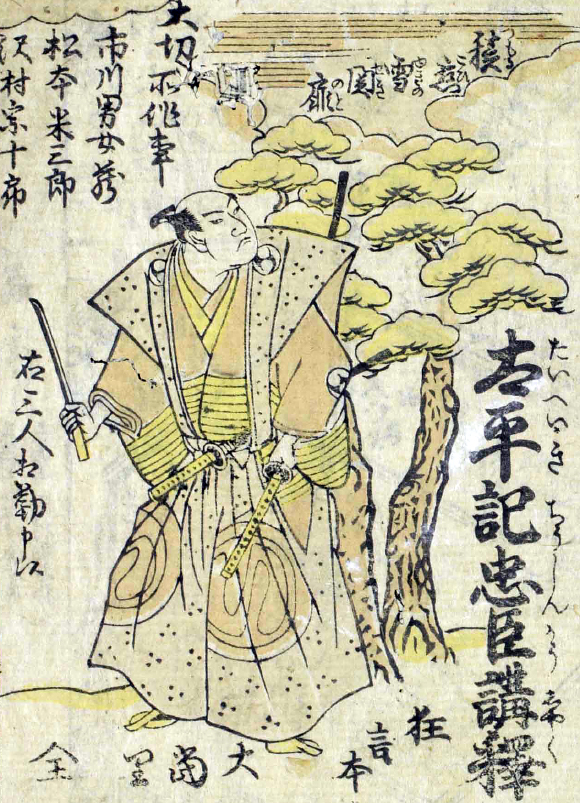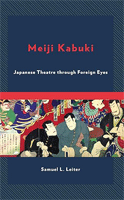| TAIHEIKI CH█SHIN KďSHAKU |
| Play title | Taiheiki Chűshin K˘shaku The Chronicle of Great Peace and a Lecture about the Loyal Retainers |
|||||||||||||||||||||
| Common title | Chűshin K˘shaku |
|||||||||||||||||||||
| Authors | Chikamatsu Hanji Miyoshi Sh˘raku Takeda Koizumo I Takemoto Saburobŕ II Takeda Bungo Takeda Heishichi |
|||||||||||||||||||||
| History |
The puppet theater drama "Taiheiki Chűshin K˘shaku" was premiered in ďsaka at the Takemotoza in the 10th lunar month of 1766. It was quickly adapted to Kabuki the following year and was premiered in the 2nd lunar month of 1767 in Edo at the Ichimuraza [casting]. It was quite popular during the Edo period but, most likely due to the cruelty of some scenes, it is nowadays a rarely-staged drama. Only one record since the end of WWII : the 4th and 5th acts of "Taiheiki Chűshin K˘shaku" were revived in July 1966 in T˘ky˘ at the T˘yoko Hall with Ichikawa Ennosuke III (Gorotar˘/Hayano Kanpei), Sawamura Tossh˘ V (Orei/Ishid˘ Nuinosuke), Sawamura Tanosuke VI (Okumi/Ukibashi) and Ichikawa Yaoz˘ IX (ďboshi Yuranosuke). |
|||||||||||||||||||||
| Structure |
The original drama was in 10 acts (12 scenes). Only 5 acts (6 scenes) have survived:
|
|||||||||||||||||||||
| Key words |
Adauchi Adauchimono Ageya Ak˘ R˘shi Ak˘-j˘ Ashikaga Tadayoshi Chűshin Chűshinguramono Gidayű Ky˘gen Gion Giri/Ninj˘ Gishi Gishi Ky˘gen G˘mon H˘s˘ Ishikiri Jigai J˘shi Kagebara Kankyo Kawara K˘shaku Kozuka Kuruwa Michiyuki ďboshi Rikiya ďboshi Yuranosuke R˘nin Semeba Seppuku Shichij˘ S˘ka Taiheiki Teraoka Heiemon Yakko Yamashina Yűjo |
|||||||||||||||||||||
| Summary |
An imperial envoy is bringing a message from the emperor to the Sh˘gun Ashikaga Tadayoshi at Kamakura. The lord in charge of the envoy's reception is K˘no Musashi-no-Kami Moronao [2]. Other lords involved, like Momoi Harima-no-Kami Yasuchika, wishing for his instructions, place an abundance of valuable gifts before him. However, En'ya Hangan Takasada, Lord of Ak˘, who arrives with Yazama Jűtar˘, offers Moronao only a box of cakes, which infuriates him. Moronao finds fault with Hangan about everything, to the point that Hangan resolves to slay his tormentor. Hearing their quarreling, ďboshi Rikiya and Hangan's brother, Ishid˘ Nuinosuke, come running. Hangan is ordered to commit seppuku, the details of which are reported by Shikama Takubŕ. Back at Ak˘ Castle, the uneasy chief retainer ďboshi Yuranosuke, who has intuited trouble from a battle fought among bees, learns of the Kamakura incident, first from his son, Rikiya, and then from Ono Sadakur˘. Yuranosuke hides his feelings by getting drunk, but Sadakur˘'s father, the retainer Ono Kudayű, insists that the clan fight the shogunate to the death. Yuranosuke receives from Rikiya the dirk with which Hangan killed himself, and resolves to take revenge. Kudayű pretends to be a loyal retainer, even to the point of disinheriting his son. Yuranosuke, seeing through his ruse, pretends he is having an affair with Hangan's widow, Kaoyo Gozen. Kudayű swallows the bait, and many clan members, as well as the family tradesman-Amakawaya Gihei-abandon Yuranosuke. Kudayű suggests to Yuranosuke that he commit seppuku. Rikiya, however, places a dirk in front of Kudayű. Yuranosuke exposes Kudayű's theft of a large amount of official money whose loss he blamed on Hayano Sanzaemon, who was forced to commit seppuku as punishment. Kudayű must kill himself, for which everyone praises Yuranosuke. Gihei is asked to prepare for the vendetta. In "Ishikiri no Kanpei," Okumi, a stonemason's daughter in Ky˘to's Shirakawa, is a stammerer, but is loved by the servant Gorotar˘ [3]. Her widowed mother, Orei, knows that Gorotar˘ is really a fencing master, and she asks him to marry Okumi and accomplish a vendetta on her behalf. Orei is Kudayű's wife and her enemy is Yuranosuke. Gorotar˘ is Hayano Kanpei, son of Hayano Sanzaemon, and he is surprised at this request. Just then, money given to Yuranosuke by Kanpei is returned to him, because Yuranosuke is suspicious about it. At this moment of seeming happiness for Orei, Kanpei reveals that he is dying from a seppuku incision made just before (see kagebara). Alone with Yuranosuke, he asks to be allowed a place in the vendetta. Yuranosuke is impressed but, while he would like to assent, cannot allow someone related to Kudayű to be part of the league. Hearing his, Okumi kills herself. Orei, repenting her husband's evil, disinherits Kanpei and Okumi, breaking their relationship with her. Yuranosuke signs Kanpei's name in blood to the vendetta list. Kanpei slices Kudayű's mortuary tablet in half. At a Gion teahouse, Ishid˘ Nuinosuke and his courtesan girlfriend, Ukibashi, perform a michiyuki dance as a parlor entertainment for guests. Moronao's supporters, Yakushiji Jirozaemon and Ono Sadakur˘, come looking for Yuranosuke and Rikiya. Seeing the dissipation of his stepson, Nuinosuke, Ishid˘ Umanoj˘ disinherits him. Nuinosuke's debauchery is a ploy to deflect suspicion of his involvement in the vendetta on behalf of his brother, Hangan. Yuranosuke, understanding, adds his name to the list, in place of the deceased Kanpei. Meanwhile, in order to support her adoptive parents, Orie, the wife of Yazama Jűtar˘, has become a streetwalker in their hometown. Jűtar˘'s younger sister, Omutsu, runs away from the quarters, where she was known as Ukibashi, and comes home. One night, in "Shichij˘ Kawara", Jűtar˘, now a fugitive being sought by the law, encounters his wife, but circumstances force them to leave one another, and he goes off in search of Moronao. In the "Kinai Sumika" scene, Orie is caring for Jűtar˘'s ailing father, Kinai, who is living in dire poverty. Jűtar˘, saying he is serving a certain daimy˘, visits Kinai dressed in beautiful garments, but the old man grows angry, saying he cannot be his son and serve two masters. To his delight, Jűtar˘ is disinherited, and he goes to the entrance where Orie passes him his son, Taiichir˘, sick with smallpox, hoping his father will train him to be a man. Jűtar˘, focused on the vendetta, refuses to be encumbered and kills the boy. Spying this, Kinai realizes Jűtar˘'s intentions, gives him money, and encourages him. Jűtar˘, after exchanging parting cups with his father, departs. Orie hears her husband's resolve and kills herself. In "Takubŕ J˘shi," [1] Yuranosuke lives alone at Yamashina, acting as if he has abandoned the vendetta. Moronao's man, Shikama Takubŕ, comes to demanding that, if Yuranosuke's intention is to serve Moronao, he should hand over the head of Tamewaka, Hangan's child. Yuranosuke pretends that the wife of the foot soldier Teraoka Heiemon has come to ask him to let her husband participate in the vendetta, and he goes inside with her son. Presently, he emerges with 100 ry˘ on a ceremonial tray stand, and places it before Shikama, who disdains it and runs out. Yuranosuke stops him, declaring his realization that Shikama is Heiemon, and rewards him for his loyalty by promoting him to samurai status and allowing him a place in the vendetta. Amakawaya Gihei has been in charge of ordering and shipping the equipment for the vendetta. He secretly lays up weapons and cavalry gear. He is captured and he, his wife, and his son, Yoshimatsu, are shackled and tortured by Moronao's followers, Umanoj˘ and Jirozaemon, for information, but he refuses to reveal who has ordered the coming night attack. Yakushiji kills the boy, for which he is censured by Ishid˘, who takes Gihei into his custody. Then, in the final act, Gihei, who is released, dreams that Hangan's forty-seven samurai kill Moronao. Teraoka Heiemon arrives with the news that the dream is a reality. Gihei recounts each detail, one by one. Heiemon kills Yakushiji at Ishid˘'s home. Nuinosuke is restored to his former position.
|
|||||||||||||||||||||
| Notes |
[1] Also called "Yamashina Kankyo", literally "a Cottage in the Village of Yamashina". |
 |
|
The cover of the ezukushi banzuke for the staging of the drama "Taiheiki Chűshin K˘shaku" in the 4th lunar month of 1800 in Ky˘to at the Minamigawa no Shibai with Sawamura S˘jűr˘ III in the role of ďboshi Yuranosuke |
|
|
| Contact | Main | Top | Updates | Actors | Plays | Playwrights | Programs | Links | FAQ | Glossary | Chronology | Illustrations | Prints | Characters | Derivatives | Theaters | Coming soon | News |


